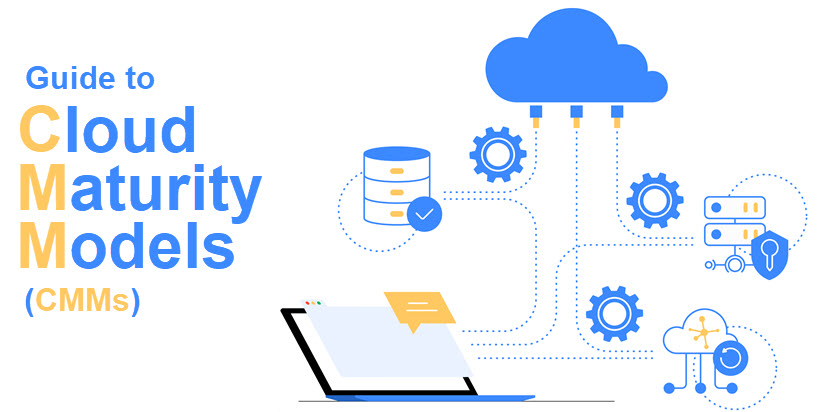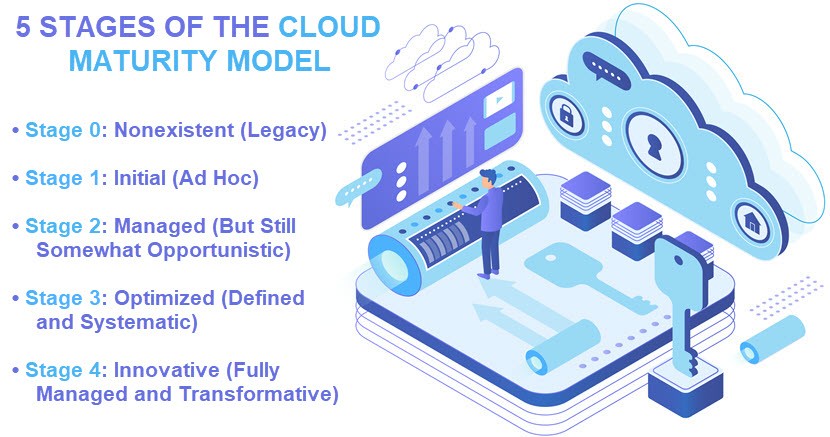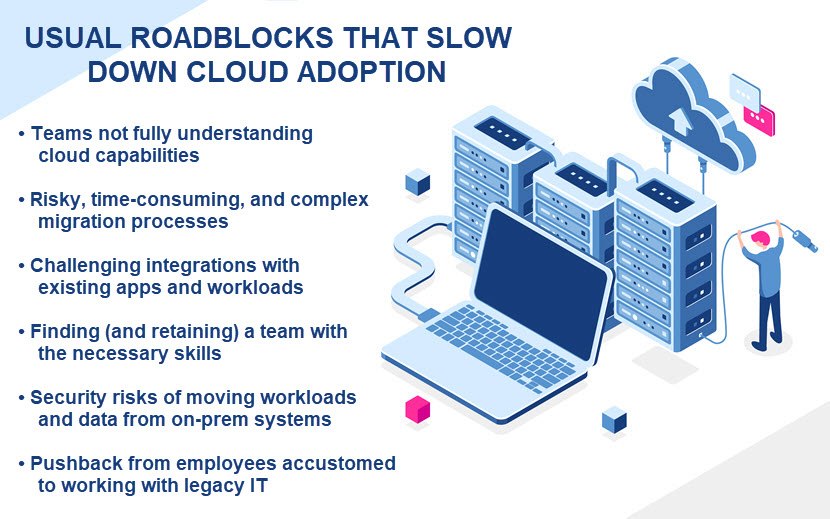What Is the Cloud Maturity Model?
Authored by Ron Cadwell, founder and CEO of phoenixNAP. Prepared for publishing by the Editorial team.
Too many business leaders see cloud adoption as a straightforward, one-time lift-and-shift operation. This mindset is a recipe for overly complex architectures, poor performance, security risks, and high IT costs (exact opposites of why companies move to the cloud in the first place).
If you're hoping to keep a cloud migration or expansion smooth, your first step should always be to assess your placement in your industry's cloud maturity model (CMM).
In this article, I'll explain the different stages of the cloud maturity model and discuss how CMMs help companies navigate and speed up their cloud journey while limiting associated risks and cost overruns.

Completely new to the cloud? That would put you at the very start of every CMM, so I'd recommend you first check out these articles:
What Is a Cloud Maturity Model (CMM)?
The cloud maturity model (CMM) is a framework that outlines the stages a company goes through when adopting cloud services (both from a tech and business perspective). CMMs help organizations evaluate the current state of cloud usage and offer guidance on how to reach higher levels of cloud maturity.
A CMM acts as a roadmap for cloud usage that typically begins with the "we've only started to use the cloud" stage and ends with the "fully embraced cloud computing" stage. Once you know your location in a CMM, the idea is to keep "maturing" and move up the model until you're happy with the way teams use the cloud.
A cloud maturity model offers support throughout the cloud journey. The model helps companies:
- Understand the way they currently use the cloud.
- Identify the desired maturity level (which does not have to be the final cloud-native stage as many organizations prefer operating lower in the CMM).
- Develop a sound and safe cloud migration plan.
- Understand expenses and industry-relevant KPIs of moving to the cloud.
- Adopt best practices, account for relevant risks, and prepare for the cultural shift of cloud adoption.
Moving up a CMM is not only about transferring more data and applications to the cloud. The framework also ensures companies adapt business policies and team culture to ensure a seamless transition to cloud-based infrastructure.
Every organization that relies on (or wants to rely on) the cloud can benefit from a CMM analysis, regardless of size or industry. The framework is especially useful for companies that are:
- Just starting to use cloud services.
- Unsatisfied with how teams use cloud-based resources.
- Planning to significantly expand the way they currently use the cloud.
- Concerned about high cloud computing costs.
- Hoping to improve cloud security or governance.
Determining your location in a CMM is a vital part of the far broader IT strategy plan, a company-wide document that outlines how the tech stack actively supports business growth and objectives.
The Benefits of a Cloud Maturity Model
Analyzing your current CMM placement and planning further steps based on a relevant model leads to a range of benefits:
- Better all-around planning: Once you assess the current maturity level, the CMM helps prioritize high-impact areas for improvement. The result is a more focused and effective cloud strategy free of low-value objectives that waste time and money.
- Improved inter-team communication: A cloud maturity model helps teams better communicate the cloud strategy and progress to stakeholders. There's a unified vision of what everyone expects from the cloud and how the team is planning to reach their goals.
- Improved app performance: Later stages of most CMMs focus on improving performance for all cloud-based and enabled apps. You'll optimize all inefficiencies and boost uptime as you move up the cloud maturity model.
- Safer cloud use: You improve governance and security posture by following the best practices and guidelines of the cloud maturity model. You also increase the likelihood of identifying vulnerabilities and exploits in your cloud-based infrastructure.
- Faster time-to-market: Later CMM stages encourage teams to get more out of cloud-based resources. Advanced and more efficient use of the cloud leads to faster time-to-market and more business agility.
- Industry-relevant benchmarking: A cloud maturity model provides a wide set of relevant KPIs and benchmarks for your industry. These metrics enable a business to carefully measure progress and compare its cloud use to peers and competitors.
- Cost savings: Moving up the model requires you to focus more on efficiency and automation, which lowers day-to-day expenses and reduces the risk of costly cloud sprawl.
Are high costs the main reason you're looking at CMMs? Check out our article on the market's top cloud cost management tools and see how to lower your monthly bill without massive IT updates.
You can also use our cloud pricing calculator to see how much cloud services should realistically set you back and get an instant quote for one of our Bare Metal Cloud servers.
The Stages of Cloud Maturity Model
CMMs have different stages and criteria based on industry and business size, but the general idea is always the same—a cloud maturity model represents a gradual progression of an organization's use of the cloud. Companies assess their current maturity level in the following ways:
- Self-assessment (typically performed via in-house analysis and surveys that ask questions about current cloud usage, governance, security, performance, etc.).
- A ready-made CMM framework (a pre-defined roadmap intended for a specific industry or business niche).
- External assessment (third-party consultants that analyze your current IT environments and provide recommendations for improvement).
Remember that most CMMs deliberately cover as many different scenarios as possible, so always take what's most relevant to you and your situation.

Stage 0: Nonexistent (Legacy)
Stage zero means that the company is exclusively relying on on-prem infrastructure. No team or department is using cloud-based resources (or their use is so minor that the top of the company has no idea about how teams use the cloud).
Being at Stage 0 is not necessarily bad. Some companies prefer working with on-prem technology or fall under some compliance that makes keeping data in the cloud too risky to be worth pursuing.
If you are a company at this stage but still want to move up the CMM, I'd recommend that you skip the next phase and try to jump straight into Stage 2.
Stage 1: Initial (Ad Hoc)
This CMM stage means that the company has only just started using cloud services. Typically, companies begin using the cloud in individual departments or projects, and are using either IaaS or SaaS (or both):
- IaaS (Infrastructure as a Service) allows teams to rent computing resources such as servers, storage, and networking.
- SaaS (Software as a Service) provides access to cloud-hosted apps over the internet (examples include Google Workspace apps, Microsoft 365, Trello, and Zoom).
Companies at this stage have no centralized strategy or governance for cloud use. While the cloud is a useful asset, there's no alignment with business objectives or any conscious effort to maximize the impact of the tech.
Main challenges of this CMM stage:
- Limited awareness about the cloud.
- Little to no executive support for cloud use.
- Lack of adoption direction and alignment with business goals.
- Teams that use the cloud are unable to purchase all required services.
- Shortage of cloud-related skills.
- No defined processes, guidelines, or go-to teams.
- Complete lack of cloud use optimization.
- A lack of understanding of associated security risks.
How to advance to the next stage:
- Get executive buy-in for cloud services.
- Perform several Proof of Concepts (POC) with non-critical apps and workloads.
- Secure appropriate funding so the team has access to all required services.
- Start defining a clear strategy for how the teams that already rely on the cloud should be using the tech.
- Begin aligning the cloud with short and long-term business goals.
- Raise the level of cloud awareness via education and training.
- Start setting clear KPIs for the use of the cloud (e.g., reduce spending on app infrastructure by 25%, lower development cost by 10%, reduce service downtime by 50%, etc.).
While risky and chaotic, the Ad Hoc stage is a vital step in an average company's cloud journey. You begin to see the potential benefits of the tech and start realizing the value of a more mature cloud strategy.
Stage 2: Managed (Yet Still Opportunistic)
Companies at Stage 2 of the cloud maturity model have started to officially organize their use of the cloud. These organizations are beginning to:
- Centralize the management of cloud resources.
- Standardize cloud adoption.
- Invest time and money into company-wide strategies for leveraging cloud services.
In addition to SaaS and IaaS, these companies are also using Platform as a Service (PaaS) to run and manage apps without the complexity of dealing with the underlying infrastructure.
Main challenges of this CMM stage:
- Cost control and management concerns.
- A limited set or a complete lack of documented policies.
- Overreliance on manual, time-consuming tasks.
- Limited visibility into how teams use the cloud.
- Scalability problems for cloud-enabled apps.
- Worries about the cost, the ROI, and the timeline of cloud adoption.
- Pushback from staff members that prefer working with legacy systems.
- Concerns about how more reliance on the cloud will affect security and compliance.
How to advance to the next stage:
- Start aligning cloud usage with business objectives (i.e., breaking into a new market, deploying new features, launching a new product, etc.).
- Establish either a Cloud Center of Excellence (CCOE).
- Organize a dedicated cloud governance team to manage cloud usage.
- Start focusing on and optimizing the TCO of cloud adoption.
- Begin enhancing the team's cloud-related skills.
- Embrace standardization, repeatability, and automation.
- Start deploying apps on containers instead of virtual machines (VMs).
- Start considering more complex but better-fitting deployment models than the public cloud (private, hybrid, community, multi-cloud, and distributed cloud).
- Start forming detailed guidelines on cloud teams, processes, migrations, and protocols.
- Improve the visibility of cloud use with cloud monitoring.
- Address encryption, authorization, and authentication concerns.
- Start moving more complex production workloads to the cloud.
- Minimize downtime for all cloud-based systems.

Stage 3: Optimized (Defined and Systematic)
Businesses at Stage 3 of CMM have fully embraced cloud computing and are using the tech to actively drive business transformation. The team is fine-tuning its use of cloud services to improve:
- App performances.
- Operational efficiency.
- IT expenses.
Like with the previous stage, companies in the Optimized phase are relying on a mix of IaaS, PaaS, and SaaS, but are also using advanced cloud features such as:
- Auto-scaling.
- Advanced monitoring.
- In-depth analytics.
Other traits of this CMM stage are advanced disaster recovery plans and security measures for protecting cloud-hosted data and apps.
Main challenges of this CMM stage:
- Ensuring all cloud-related processes are consistent.
- Training the staff to expand their competencies.
- Managing cloud environments effectively.
- Analyzing workloads to seek optimization opportunities.
- Identifying workloads and tasks fit for automation.
- Environment management concerns.
- Migration of all targeted apps and systems.
How to advance to the next stage:
- Get buy-in for full IT decentralization.
- Create a complete app migration strategy from the current to the target state environment.
- Improve release, secret, and policy management.
- Ensure robust management and effective governance.
- Move all relevant workloads and data into the cloud.
- Start experimenting with advanced cloud services (AI, machine learning, blockchain, Big Data, data science, etc.).
- Fully embrace automation and orchestration.
- Start moving away from on-prem data centers (unless you're running a private cloud, either solo or as a part of a hybrid architecture).
Stage 4: Innovative (Fully Managed and Transformative)
At Stage 4, an organization’s use of the cloud becomes a continuous cycle of optimizing cloud infrastructure. All cloud processes are highly documented, and teams make all changes based on strictly defined protocols.
These companies also have in-depth governance rules and are looking to use the cloud to stay ahead of the competition. Businesses at this stage of the cloud maturity model are actively using cloud-based services to:
- Create new business models and revenue streams.
- Drive innovation across the organization.
In addition to using features present in previous stages, these companies are also relying on emerging technologies to boost cloud usage, including:
At this stage, all legacy apps are now running in the cloud. Also, all new apps are cloud-aware and reliant on cloud traits (self-service provisioning, elasticity, run-anywhere design, etc.).
Main challenges of this CMM stage:
- Continuously optimizing the cloud to improve user satisfaction.
- Ensuring cloud costs do not spiral out of control.
- Occasional strategic cloud and data repatriation.
- Keeping up with the latest technologies and cloud trends.
- Ensuring the team only deploys born-in-the-cloud and cloud-native apps.
- Motivating the team to keep learning about cloud capabilities.
Remember that you do not have to strive for later stages of the CMM at all costs. Reaching the Innovative stage is expensive, time-consuming, and not ideal for every use case and team. Staying in the Managed or Optimized stage (permanently or for now) is a valid choice.
Go-To Blueprints for Cloud Journeys
Is the CMM a golden recipe that guarantees cloud success? No, but a model gives business leaders a clear idea of where they are in the cloud adoption process compared to industry peers. You identify areas for improvement, get a sense of what it takes to move up a stage or two, and put the whole adoption strategy into a better context—how much more can you expect from a ready-made framework?